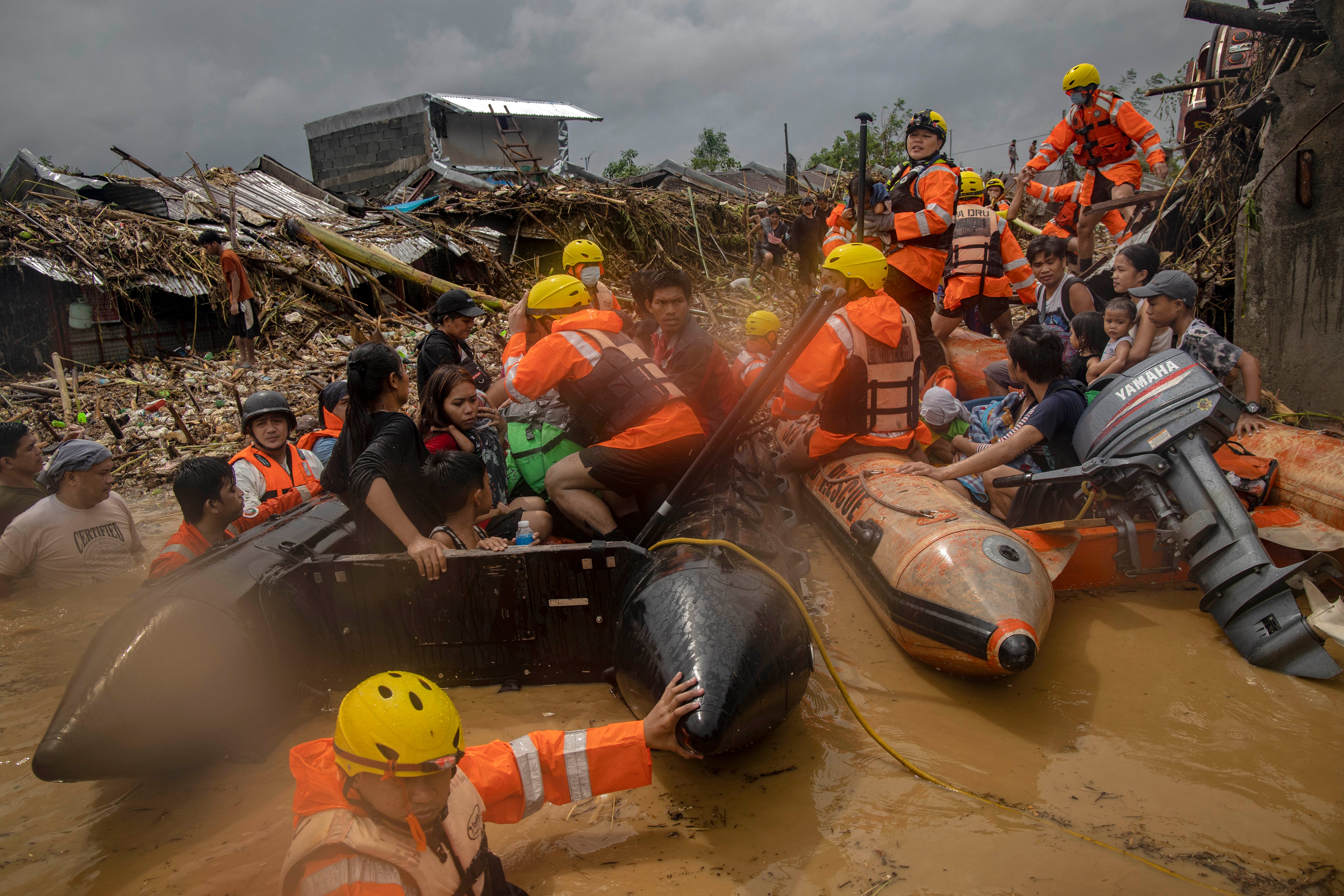Climate crisis in 2020: A glimpse of what’s to come and a glimmer of hope
This year saw prolonged heat in the Arctic, the busiest Atlantic storm season on record and unprecedented bushfires. But it also saw many world leaders commit to tougher measures to tackle the climate crisis, writes Daisy Dunne


The year started with some disturbing images from Australia. Scorched koalas. The beginning of 2020 marked the mid-point of Australia’s 2019-2020 bushfire season, which saw a record amount of land burned in the east of the country. More than 30 people died in the bushfires, including nine firefighters. Conservative estimates suggest more than one billion mammals, birds and reptiles also perished in the flames.
Though the reasons behind every wildfire are complex, analysis found that the climate crisis likely played a role in Australia’s severe fire season. The quick-fire research published in January found that the weather conditions like those seen at the height of Australia’s fires have become at least 30 per cent more likely since 1900 as a result of human-caused climate change.
“I would say 2020 really brought home how vulnerable we are, as a global society, to even comparatively small changes in natural hazards,” Dr Friederike Otto, a co-author of the fires analysis and associate director of the Environmental Change Institute at the University of Oxford, tells The Independent.
“Even in Australia, a rich country that is well used to fires, this year’s bushfires were very close to the edge of what the population and fire fighters could cope with,” she adds. “This demonstrated that we are really only adapted to a very narrow range of possible weather that we have gotten used to over the centuries.”
A similar story was seen in North America towards the end of the year, says Dr Cristina Santin, a wildfires researcher from Swansea University. This year’s record-breaking fire season in the western US saw dozens of large and intense fires break out across the states of California, Oregon and Washington. This included the country’s first “gigafire” – a fire that burned through more than one million acres of land.
“As far as I am aware there is not yet a specific study about this year’s fire season in the western US,” says Dr Santin. “However, there are several studies already showing that in the western US the increase in fire activity currently observed is partially driven by drier and hotter conditions resulting from climate change.”
One factor heightening fire risk in many different parts of the world is increasing extreme heat, the scientists say. And this year saw more heat records broken across the globe. In August, a weather station in Death Valley, California, hit 54.4C. If verified, this will be the hottest temperature ever reliably recorded on Earth.
Meanwhile, the Arctic region also saw unprecedented heat this year. On 20 June, a weather station in Verkhoyansk, a town in Siberia, hit 38C – a new record for the Arctic region. Overall, temperatures in Siberia were more than 5C above average from January to June of this year. The unusual warmth played a key role in driving polluting fires across frozen peatland in the Arctic region.
Rapid analysis released in July found Siberia’s prolonged heat would have been “almost impossible” if it were not for the climate crisis.
Many other parts of the world also battled extreme temperatures this year, says Dr Otto. In some regions, including sub-Saharan Africa, many of these heat extremes still go unrecorded.
She adds: “Twenty-twenty showed us more than ever that climate change is a real game-changer when it comes to heat extremes. And heat is a killer. In Europe it is by far the deadliest natural hazard, while simultaneously the one being made more intense and more frequent by orders of magnitude because of climate change.
“In many other parts of the world, it simply isn’t possible to assess heat mortality because the data is not recorded.”
Countless more record-breaking extreme weather events were seen across the world. This year’s Atlantic hurricane season broke the record for the number of storms strong enough to be given names in a single year. The strongest storms to hit the Americas this year included Hurricane Eta, a category four storm that killed more than 100 people as it made landfall in Central America, and Hurricane Laura, which killed 77 people and caused $14bn in damage after making landfall in Louisiana.
Meanwhile, several countries in Asia, including the Philippines, India and Sri Lanka, also faced intense storms. After Typhoon Goni struck the Philippines in November, Jacques Fallaria, a 19-year-old climate activist from Bulacan, told The Independent: “It was an apocalypse, a circumstance you can't even imagine. On social media, we saw floating bodies on flash floods.
“The situation we are in right now should send proof to our world leaders that climate change is real and institutions should be held accountable for what has just happened in our country.”
The drivers behind trends in major tropical cyclones – known as “typhoons” in the northwest Pacific Ocean and “hurricanes” in the North Atlantic – are complex, and include the influence of natural ocean and atmosphere cycles.
Despite this, there is some evidence to suggest that the climate crisis could be influencing the severity of major storms. Research has shown that, globally, major tropical cyclones have become 15 per cent more likely over the past four decades. One reason for this could be because tropical cyclones use warm, moist air as fuel and, as oceans heat up, more of this fuel is becoming available.
The UK also experienced record downpours this year. The country faced its wettest February on record as storms Dennis and Ciara hit in quick succession, causing severe flooding in areas including Cumbria, Wales and Yorkshire. In October, the UK also experienced its wettest day on record, in which enough water fell to fill Loch Ness.
The onslaught of extreme weather in 2020 is a glimpse of what’s likely to come in the years ahead. The rapid analysis following Australia’s bushfires found that weather conditions similar to those seen from 2019-20 will become at least four times more likely if global temperatures reach 2C above pre-industrial levels, when compared with 1900.
At present, the world is around 1.2C hotter than it was in pre-industrial times. And current policies from world leaders would likely take us to around 3C of global warming by the end of the century.
Britain faced its wettest February on record as storms Dennis and Ciara hit in quick succession, causing severe flooding in areas including Cumbria, Wales and Yorkshire
However, this year has offered us some reasons to be hopeful, says Nick Mabey, chief executive and founding director of the climate think tank E3G. “With China, Japan, and South Korea joining the likes of the EU and UK in setting net-zero targets, this year has demonstrated that climate action supersedes geopolitical tensions and that the Paris Agreement goals are still crucial for all,” he tells The Independent.
In the summer of 2019, the UK became the first major world economy to make the pledge to hit net-zero emissions by 2050. Reaching net zero will be key to the world meeting the goals of the Paris Agreement, an international treaty promising to keep global warming “well below” 2C, with the aim of keeping temperatures at 1.5C.
This year, similar net-zero pledges were made by the EU, Japan and South Korea. China, the world’s largest emitter, shocked the world in October when it too announced intentions to reach “carbon neutrality” – at a slightly later date of 2060.
And in November, Joe Biden took victory in the US election over Donald Trump, who had spent his presidency denying climate science and rolling back environmental measures. Among Biden’s ambitious package of climate measures, he has pledged to commit the US, the world’s second largest emitter, to net-zero emissions by 2050.
“The biggest moment for climate change in 2020? Pennsylvania turning blue,” Prof Dave Reay, director of the Edinburgh Centre for Carbon Innovation at the University Of Edinburgh, tells The Independent. “That screen-refreshing moment when Biden overtook Trump in the key swing state for the US presidency pivoted the whole world towards a different climate future.
“I was on an author call with climate scientists from around the world at the time. As 'Penn went blue' we paused the meeting and all of us, US colleagues and everyone else, punched the air.”
Though Biden might still face trouble getting his ambitious climate plans through the Senate, his appointment still marks a major turning point for the climate crisis, experts say. One reason for this is because Biden is expected to use the country’s political weight to encourage other countries to up their climate ambitions. Biden has already pledged to hold a climate action summit for world leaders after he enters office in 2021.
As 'Penn went blue' we paused the meeting and all of us, US colleagues and everyone else, punched the air
He has also pledged to rejoin the Paris Agreement, after Trump officially pulled the country out of the deal in November. An analysis published shortly after Biden’s win found that, if all new net-zero pledges made in 2020 were realised, it could hold global temperatures to as low as 2.1C by the end of century.
"Twenty-twenty will forever be remembered for the horror of Covid, but there's a real chance it will also have a footnote in the history books as a year when a small bit of blue in the northeast of America tinged the whole world with green,” says Prof Reay.
This year has also seen major new green commitments from the UK, the country due to host a key round of UN climate talks in 2021, says Sam Hall, director of the Conservative Environment Network. “Domestically, the critical moment came this November, as the prime minister personally launched an ambitious, economy-wide green jobs plan,” says Hall.
On 18 November, Boris Johnson launched a new 10-point plan for tackling the climate crisis in the UK. Though the plan was criticised by some green groups, it contained some ambitious measures to tackle emissions in the UK. For example, Johnson brought forward a ban on the sale of new petrol and diesel vehicles to 2030.
“The decision to end the sale of new petrol and diesel cars by 2030 was particularly ambitious, and will help to accelerate the uptake of electric cars, improving air quality across the country,” says Hall.
All eyes will be on the UK in 2021 in the run-up to the UN climate talks, known as Cop26, which are due to be held in Glasgow from 1-12 November. To get the world on track to meet the targets of the Paris Agreement, Johnson’s government will need to galvanise greater action from all world countries.
“With the imminent re-entry of the US to global efforts to tackle climate change and the EU now proposing to centre climate in the transatlantic relationship, we should expect to see world leaders putting climate at the centre of the foreign policy in the run-up to Cop26,” says Mabey.

Join our commenting forum
Join thought-provoking conversations, follow other Independent readers and see their replies
Comments